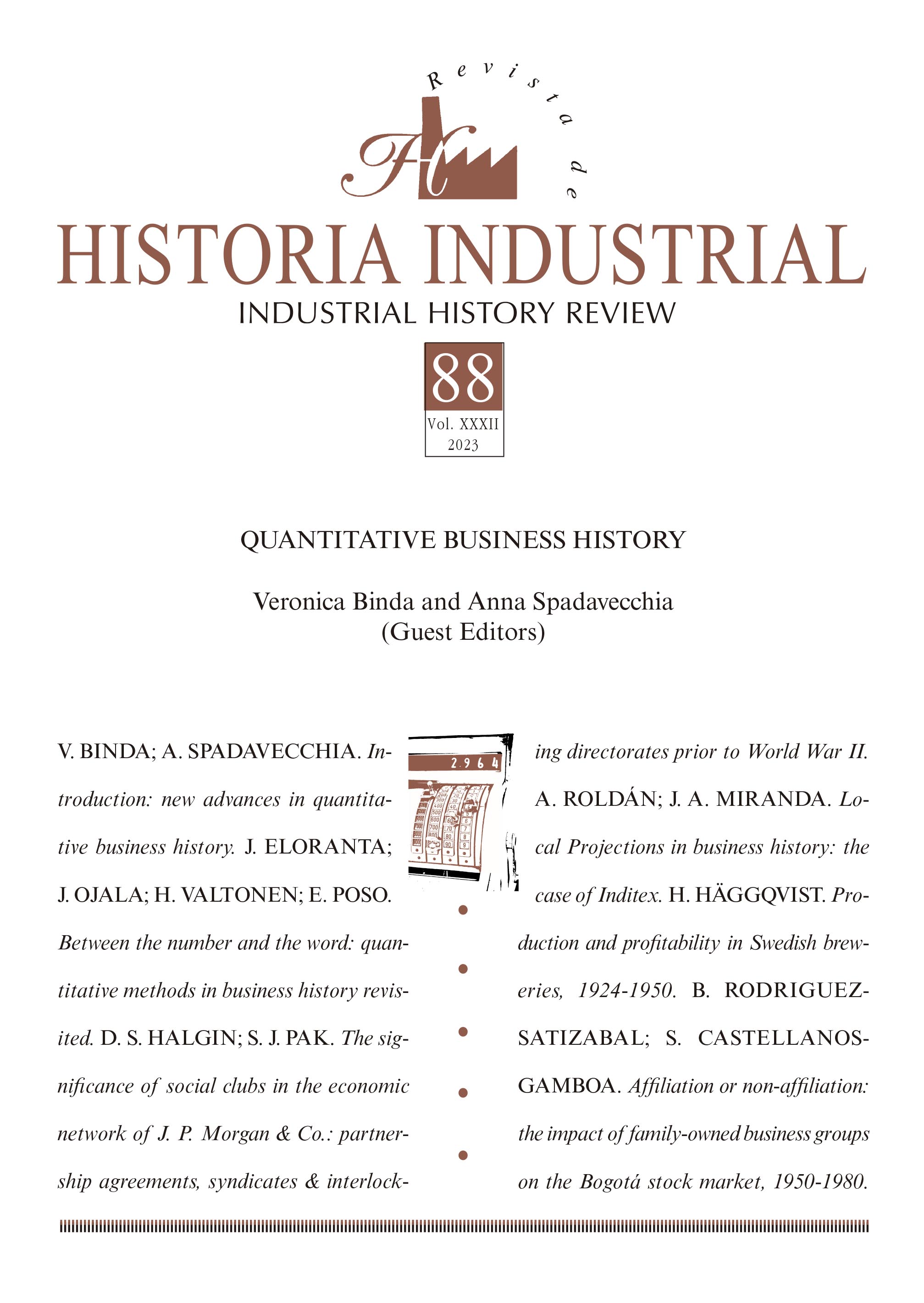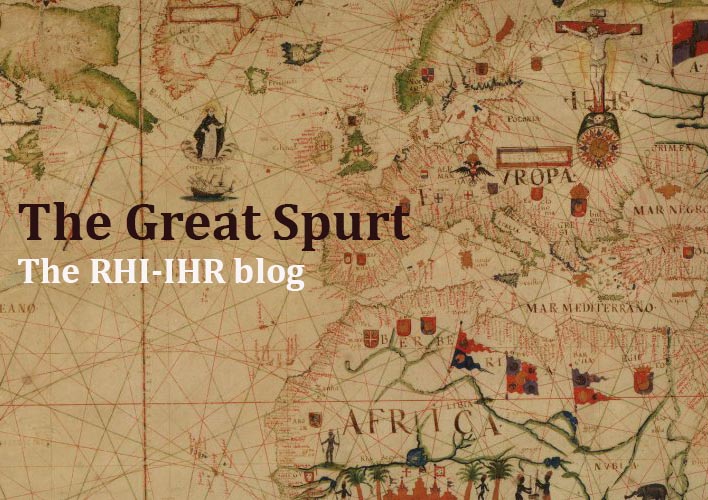Production and profitability in Swedish breweries, 1924-1950
DOI:
https://doi.org/10.1344/rhiihr.40772Keywords:
business history, alcohol policy, breweries, SwedenAbstract
Sweden’s alcohol policy during the 20th century was one of the strictest in Europe and it affected producers, such as alcoholic-beer brewers. This article analyses how production and profitability developed among brewery firms following the 1923 prohibition of strong beer. Breweries tried to find other high-return opportunities, for example by increasing the production of non-alcoholic beverages and reaching other segments of the consuming public. However, both production and profitability declined, hence diversification seems to have been rather negative for the brewery industry, although not for all its actors. The article concludes that while diversification gave breweries a way to reach other consumers, it was the largest actors that were best placed to reap the benefits of the closed-off market environment. Thus, the article shows how diversification of production may be a result of government intervention, which will affect firm performance negatively or positively, depending on market structure, competition, and cost structure.
Downloads
References
Anell, Barbro, and Bo Persson. 1983. Bryggerinäringen och pilsnerpolitiken: en studie av industriell omvandling och politiska interventioner. Linköping: Department of Management and Economics.
Arnold, A. J. (1999). ‘Profitability and capital accumulation in British industry during the transwar period, 1913–1924’, Economic History Review, 52 (1): 45-68.
Attman, Artur. 1961. Bryggerinäringen i Göteborg II: 1810–1961. Göteborg: Oscar Isacsons Boktryckeri Aktiebolag.
Bertrams, Kenneth, Julien Del Marm ol, Sander Geerts, and Eline Poelmans. 2019. Becoming the World’s Biggest Brewer: Artois, Piedbouef, and Interbrew (1880-2000). Oxford: Oxford University Press.
Bhuyan, Sanjib, and Michael McCaff erty. 2013. ‘U.S. Brewing Industry Profitability: A Simultaneous Determination of Structure, Conduct, and Performance’, Journal of Agricultural & Food Industrial Organization, 11 (1): 139-150.
Box, Marcus. 2017. ‘Bring in the brewers: business entry in the Swedish brewing industry from 1830 to 2012’, Business History, 59 (5): 710-743.
Cabras, Ignazio, and David. M. Higgins. 2016. ‘Beer, brewing, and business history’, Business History, 58 (5): 609-624.
Colli, Andrea. 1998. ‘The Italian brewing industry, c. 1815-1990’. In The Dynamics of the International Brewing Industry Since 1800, edited by Richard George Wilson and Terence Richard Gourvish, 18-45. New York: Routledge.
Da Silva Lopes, Teresa. 2007. Global Brands: The Evolution of Multinationals in Alcoholic Beverages. Cambridge: Cambridge University Press.
Dahm en, Erik. 1950a. Svensk industriell företagarverksamhet: kausalanalys av den industriella utvecklingen 1919–1939. Bd 1. Stockholm: Industriens utredningsinstitut.
Dahmen, Erik. 1950b. Svensk industriell företagarverksamhet: kausalanalys av den industriella utvecklingen 1919–1939. Bd 2. Stockholm: Industriens utredningsinstitut.
Enflo, Kerstin, Martin Henning, and Lennart Sch on. 2014. ‘Swedish regional GDP 1855–2000: Estimations and general trends in the Swedish regional system’, Research in Economic History, 30 (1): 47-89.
Folin, Sune, and Inge Uvebr ant. 1968. Bryggerinäringen: en studie i svensk branschrationalisering. Göteborg: Kulturgeografiska institutionen.
Garavaglia, C., and Johan Swinnen. 2018. ‘Economics of the Craft Beer Revolution: A Comparative International Perspective’. In Economic Perspectives on Craft Beer, edited by Christian Garavaglia and Johan Swinnen. Cham: Palgrave Macmillan.
Gourvish, Terence R., and Richard G. Wilson. 1985. ‘Profitability in the British Brewing Industry, 1885–1913’, Business History, 27 (2): 146-165.
Hamberg, Ove. 1985. Svensk bryggeriindustri 1885–1985. Stockholm: Svenska bryggareföreningen.
Hawkins, Kevin. H., and Christopher L. Pass. 1979. The Brewing Industry: A Study in Industrial Organisation and Public Policy. London: Heinemann.
Hogarty, Thomas. F., and Kenneth Elzinga. 1972. ‘The Demand for Beer’, The Review of Economics and Statistics, 54 (2): 195-198.
Horowitz, Ira, and Ann R. Horowitz. 1965. ‘Firms in a Declining Market: The Brewing Case’, The Journal of Industrial Economics, 13 (2): 129-153.
Industriens Utredningsinstitut (IUI). 1953. Den svenska bryggeriindustrien: Några huvuddrag i den skattepliktiga bryggeriindustriens produktions- och distributionsstruktur. Stockholm.
Iwaski, Natsuko, Barry J. Seldon, and Victor J. Tremblay. 2008. ‘Brewing Wars of Attrition for Profit (and Concentration)’, Review of Industrial Organization, 33 (1): 263-279.
Johansson, Lennart. 2008. Staten, supen och systemet: svensk alkoholpolitik och alkoholkultur 1855–2005. Stockholm: Symposium.
Karlsson, Thomas, and Esa Osterb erg. 2001. ‘A scale of formal alcohol control policy in 15 European countries’, Nordic Studies on Alcohol and Drugs, 18 (1, suppl.): 117-131.
Lenke, Leif. 1989. Alcohol and criminal violence: time series analyses in a comparative perspective. PhD Thesis, Stockholm: Stockholms Universitet.
Lindblad, Hans, and Sven Lundkvist. 1996. Tusen nyktra: 100 år med riksdagens nykterhetsgrupper. Stockholm: Sober.
Lundqvist, Torbjörn. 1995. Den stora ölkartellen: branschorganisering och kartellbildning i bryggeriindustrin 1885–1914. PhD Thesis, Uppsala: Uppsala Universitet.
Lynskey, Michael, J. 2006. ‘The Locus of Corporate entrepreneurship: Kirin Brewery’ s Diversification into Biopharmaceuticals’, Business History Review, 80 (4): 689-723.
Markides, Constantinos C., and Peter J. Williamson. 1995. ‘Related diversification, core competences and corporate performance’, Strategic Management Journal, 15 (1): 149-165.
Millns, Tony. 1996. ‘The British Brewing Industry, 1945–95’. In The Dynamics of the International Brewing Industry Since 1800, edited by Richard G. Wilson and Terence R. Gourvish, 125-140. New York: Routledge.
Mitch ell, Brian R. 2003. International historical statistics: Europe, 1750–2000. New York: Palgrave Macmillan.
Nycander, Svante. 1996. Svenskarna och spriten: alkoholpolitik 1855–1995. Stockholm: Sober.
Palepu, Krishna. 1985. ‘Diversification strategy, profit performance and the entropy measure’, Strategic Management Journal, 6 (3): 239-255.
Poelmans, Eline, and Johan Swinnen. 2011. ‘A Brief History of Beer’. In The Economics of Beer, edited by Johan Swinnen. Oxford: Oxford University Press.
Poelmans, Eline, Jason E. Taylor, Samuel Raisanen, and Andrew C. Holt. 2022. ‘Estimates of employment gains attributable to beer legalization in spring 1933’, Explorations in Economic History, 84: 1-20.
Prais, Sigbert John. 1981. Productivity and Industrial Structure: A Statistical Study of Manufacturing Industry in Britain, Germany and the United States. Cambridge: Cambridge University Press.
Rumelt, Richard. P. 1974. Strategy, Structure, and Economic Performance. Boston: Harvard Business School.
Rumelt, Richard. P. 1982. ‘Diversification Strategy and Profitability’, Strategic Management Journal, 3 (1): 359-369.
Sandberg, Peter. 2006. Kartellen som sprängdes: Svensk bryggeriindustri under institutionell och strukturell omvandling 1945–1975. PhD Thesis, Göteborg: Göteborgs universitet.
Sandberg, Peter. 2010. ‘The creation of big business in the Swedish brewing industry during the aftermath of the Second World War’, Scandinavian Economic History Review, 58 (1): 43-59.
Sandberg, Peter. 2022. Svensk bryggerihistoria: öltillverkning under 200 år. Lund: Historisk Media.
Scherer, Frederic, M., and David Ross. 1990. Industrial market structure and econòmic performance. Dallas: Houghton Mifflin.
Schon, Lennart. 2010. Sweden’s Road to Modernity: an economic history. Stockholm: SNS.
Sundstrom, Åke, and John Ekstrom. 1962. Dryckeskonsumtionen i Sverige. Stockholm: Almqvist & Wiksell.
Statens Offentliga Utredningar (SOU), 1923: 32, “Sveriges bryggeriindustri”.
Statens Offentliga Utredningar (SOU), 1936: 5, “Revision av lagstiftningen rörande tillverkning, beskattning och försäljning av maltdrycker”.
Statens Offentliga Utredningar (SOU), 1952: 55, “Tillverkning och försäljning av maltdrycker”.
Statens Offentliga Utredningar (SOU), 1959: 46, “Ölfrågan”.
Statistisk arsbok, various issues.
Svensk industrikalender, Industriförbundet, 1947.
Sveriges aktiebolag, various issues.
Sveriges Industriforb und. 1948. Sveriges industri: översikt 1948. Stockholm: Sveriges Industriförbund.
Sveriges Officiella Statistik (SOS), Handel, various issues.
Sveriges Officiella Statistik (SOS), Industri, various issues.
Swinnen, Johan, and Devin Briski. 2017. Beeronomics: How beer explains the world. Oxford: Oxford University Press.
Teece, David J. 1982. ‘Towards an economic theory of the multiproduct firm’, Journal of Economic Behavior and Organization, 3 (1982): 39-63.
Tingsten, Herbert. 1967. Den svenska socialdemokratins idéutveckling 2. Stockholm: Bonniers.
Vaizey, John. 1960. The Brewing Industry 1886–1951: An Economic Study. London: Issac Pitman and Sons.
Downloads
Published
How to Cite
Issue
Section
License
Copyright (c) 2023 Revista de Historia Industrial — Industrial History Review

This work is licensed under a Creative Commons Attribution 4.0 International License.
The author assigns all rights to the publisher. Creative Commons
The author who publishes in this journal agrees to the following terms:
- The author assigns all intellectual property rights exclusively to the publisher for the entire duration of the applicable intellectual property rights.
- The publisher will distribute the texts under the Creative Commons Attribution License, which allows others to share the work, provided that they acknowledge the authorship, its initial publication in this journal, and the conditions of the license.





